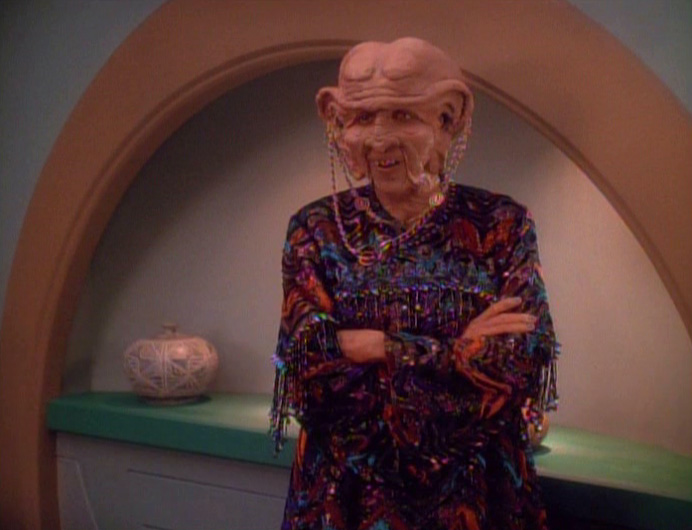 If asked to describe the overarching plot of Deep Space 9 you’d probably think of how they helped the war torn Bajor recover from a century of military occupation by Cardassia while trying to prevent the Federation from facing the same fate under the Dominion. But another smaller plotline is quite interesting to consider: the Ferengi feminist revolution. The timeline of this revolution that saw Ferengi women go from being imprisoned in their homes, banned from wearing clothes, and financially dependent on male relatives to being free to leave their homes, clothed, and financially independent in a few brief years is stunning. This is massive progress in a very compressed timeframe. There could be various factors that fast tracked feminism within the Ferengi Alliance, including the war itself, but brief comments about Ferengi society hint at some more interesting factors that could have made it so successful in a compressed time. There are hints that there had been attempts by Ferengi women to circumvent the laws that oppressed them prior to this. Could the revolution have been secretly building steam for unknown years until the final bar of latinum tipped the scales to feminism?
If asked to describe the overarching plot of Deep Space 9 you’d probably think of how they helped the war torn Bajor recover from a century of military occupation by Cardassia while trying to prevent the Federation from facing the same fate under the Dominion. But another smaller plotline is quite interesting to consider: the Ferengi feminist revolution. The timeline of this revolution that saw Ferengi women go from being imprisoned in their homes, banned from wearing clothes, and financially dependent on male relatives to being free to leave their homes, clothed, and financially independent in a few brief years is stunning. This is massive progress in a very compressed timeframe. There could be various factors that fast tracked feminism within the Ferengi Alliance, including the war itself, but brief comments about Ferengi society hint at some more interesting factors that could have made it so successful in a compressed time. There are hints that there had been attempts by Ferengi women to circumvent the laws that oppressed them prior to this. Could the revolution have been secretly building steam for unknown years until the final bar of latinum tipped the scales to feminism?
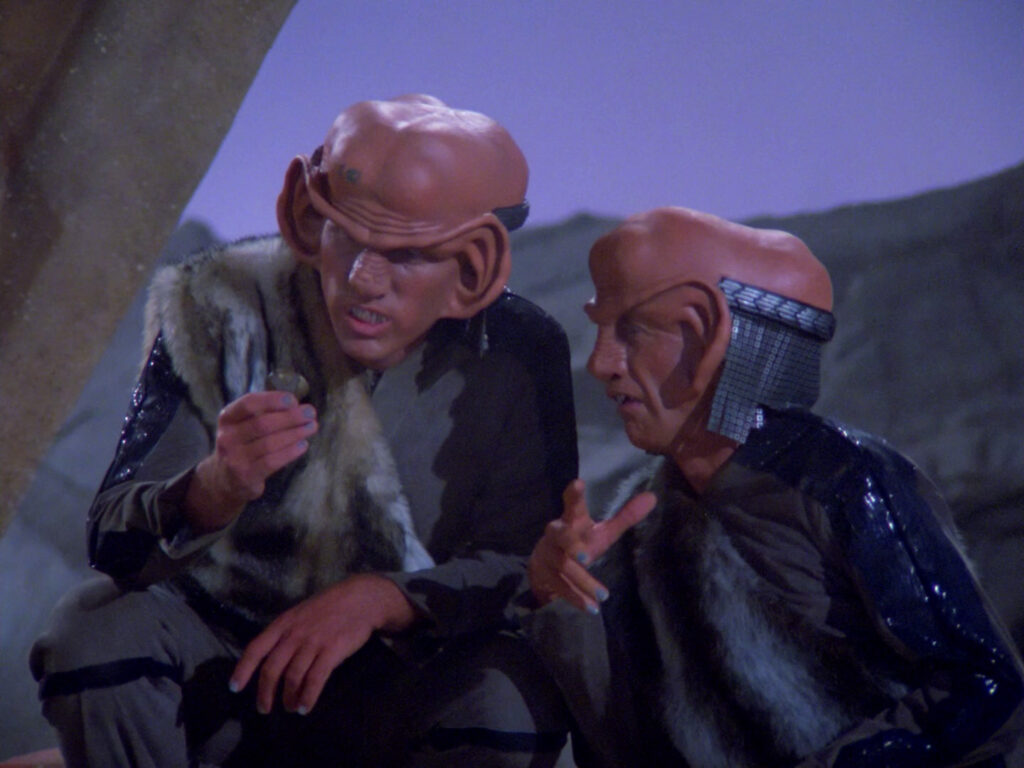
Although the Ferengi in their original appearance, The Next Generation episode, “The Last Outpost” are not the scheming businessmen of DS9, the misogynistic traits the species became known for are already present. They disparage Yar multiple times, showing obvious disgust at a woman being forced to (from their perspective) wear clothing, carry a weapon, and work alongside men. Later episodes of TNG would prove how sexist Ferengi society is, most notably in the episode “Menage à Troi” when Deanna and Lwaxana Troi are kidnapped by Ferengi and treated as sexual objects, including both being stripped and Lwaxana having to perform oo-mox on their captor to aid in their escape. Oo-mox itself is a prime example of the sexism of Ferengi society; later episodes show Ferengi men coercing employees to perform oo-mox or hiring women from other species to perform oo-mox on them during business meetings as a conspicuous display of wealth, equivalent to wearing Rolex watches, driving Ferraris, or wearing clothing from certain brands in 20th century human society. It is also important to note that Ferengi women like Ishka are never seen receiving oo-mox from their romantic partners. It is also noticeable that in the Rules of Acquisition, the business laws that form the basis of Ferengi society, there is a law that specifically mentions men receiving oo-mox, but not women. Is this due to oo-mox not being as pleasurable for women or more based on the misogyny of Ferengi society overall?
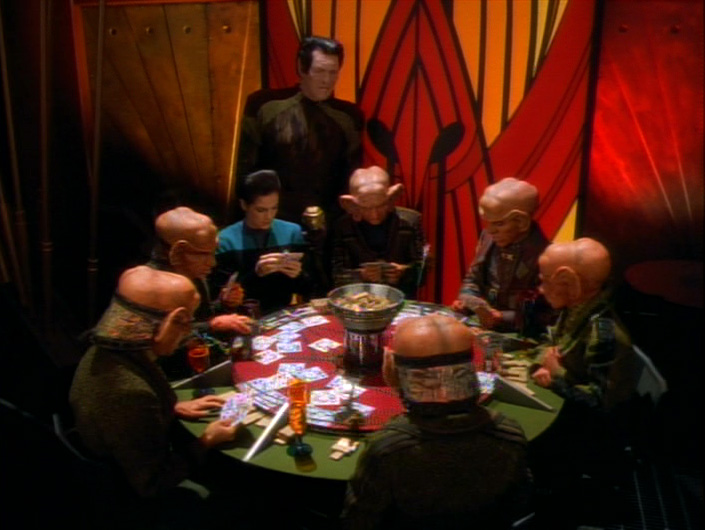
Although the leader of the Ferengi Feminist Revolution, Ishka aka Moogie, wouldn’t show up until the third season, season two of DS9 has Pel, a Ferengi woman already opposing the patriarchal Ferengi society as she uses her business acumen to make profit for herself. Disguised as a Ferengi man, she advises Quark as well as Grand Negus Zek on business in her only appearance, the episode “Rules of Acquisition.” She ends up leaving the Alpha Quadrant for the Gamma Quadrant to pursue business outside of Ferengi space where a Ferengi woman could earn profit on her own. Sadly, Pel never returns in DS9, but her presence proves that Ishka is not the only trailblazer and also opens up the possibility that some Ferengi women have been earning their own profit prior to this, but not openly as women, just like many women disguised themselves as men to avoid marriage or earn a living not available to women in Western European history.
The case against Ishka, made by Liquidator Brunt, a financial enforcer and antagonist to Quark, in the episode “Family Business” reveals that Pel and Ishka may just be the tip of the iceberg, as there are already established laws explicitly excluding women from earning profit. Brunt also describes the consequences of women earning profit – either sign a confession or the women could be sold into servitude while their male family members had to accept financial responsibility. At no point does anyone refer to this as unprecedented or explain they had to call a special meeting of the Grand Nagus and the DaiMons to decide on a punishment. So if these measures are established in Ferengi law, this indicates previous generations of Ferengi created these laws in response to women earning profit. Ferengi history is not deeply explored within DS9, but there is a hint in the episode “Prophet Motive” where the Prophets, disgusted by Grand Nagus Zek going through the wormhole to bother them about business opportunities, claim to have reverted him to a previous state of Ferengi mentality, that is much less greedy and profit obsessed. Did Ferengi misogyny grow alongside their love of profit?
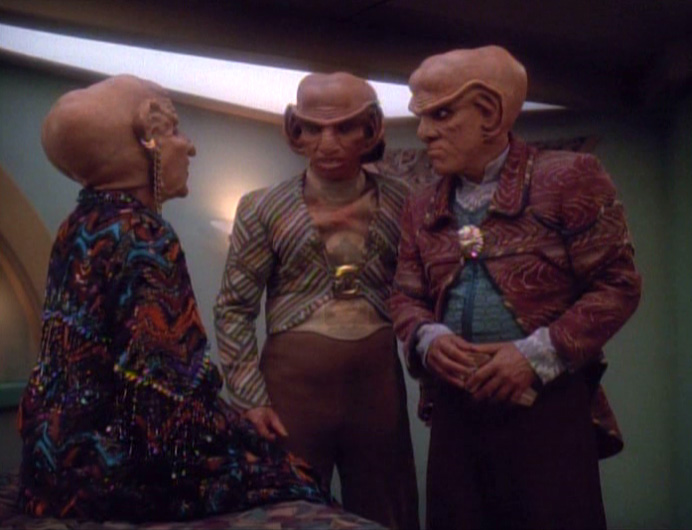
“Family Business” has a very interesting discussion that often gets overlooked – Ishka and Quark are arguing and she retorts that his and Rom’s father had no lobes for business. Rom seems to have taken after his father, whereas Quark has taken after her. She then mentions that she taught them both the Rules of Acquisition. Later episodes would reveal that Ferengi women are not allowed to learn to read, implying that Ferengi women learn the Rules of Acquisition through oral repetition. As Quark and Rom are seen consulting a written version of the Rules of Acquisition at other points in DS9, it proves there is a physical record, but since women are barred from the Ferengi system of education via apprenticeship, women are implied to learn the Rules of Acquisition through overhearing their male relatives discuss them then committing them to memory. Since Ferengi women are forbidden from leaving their homes without a male family member escorting them and talking with non-relatives is prohibited, this could imply that in Ferengi households with multiple women the conversations about the Rules of Acquisition are very in depth and possibly the only topic of conversation due to how sheltered their lives are.
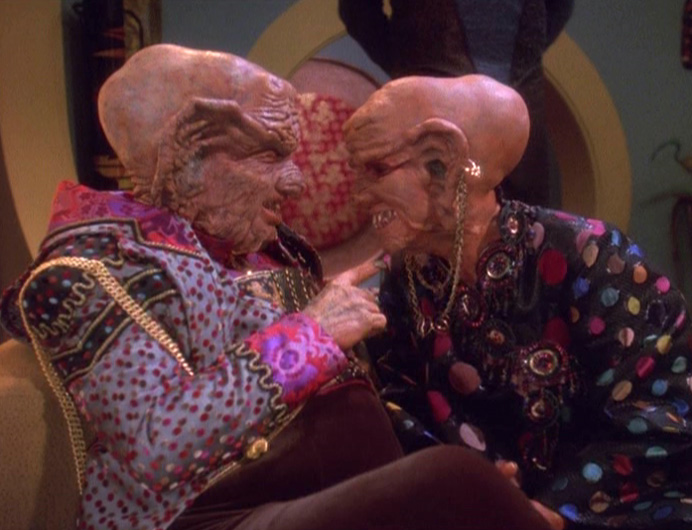
Since Ferengi society is obsessed with profit, to the point that Ferengi auction off parts of their own corpses, it makes sense that when Ishka and Grand Nagus Zek become a couple and Ishka influences Zek enough that he starts changing the laws to allow Ferengi women more freedom, one of the main ways they are able to do so is by appealing to the profit opportunities that will open up as Ferengi women become liberated. The infamous episode “Profit and Lace” has several very awkward scenes of Quark, having gone through a sex change operation to become a female Ferengi named Lumba talking with a Ferengi business owner, Nilva, about how allowing women to earn profit means that they will have money to spend on products, thus boosting the Ferengi economy and creating new business opportunities. Lumba points out that the main product of Nilva’s company, Slug-o-Cola, could appeal to female Ferengi to regain the edge over the company that produces a rival drink, Eelwasser. This is in addition to the new businesses that will have to start producing clothing and other products for women on Ferenginar.
The Ferengi Feminist Revolution seems to have been a very brief, fast, and straightforward process where Ferengi women were able to make massive strides to becoming equal to their male peers. While the exact time frame is not given within DS9, the women of Ferenginar are revealed to have gone from being treated as property with no rights and very restricted access to society as a whole to being major players in the future of the Ferengi Alliance. Hints sprinkled throughout DS9 indicate that Ferengi women may have been fighting this oppression for much longer than many male leaders have realized and that previous generations of Ferengi men have taken legal steps to keep women subjugated, but the revolution with legal changes for women was very rapid. Ferengi women like Pel and Ishka used the restrictions their society placed on them to hone the business acumen to the point they were able to outwit the Ferengi patriarchy.